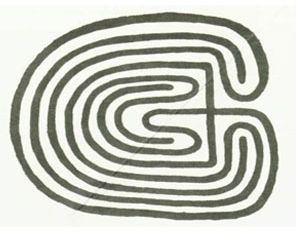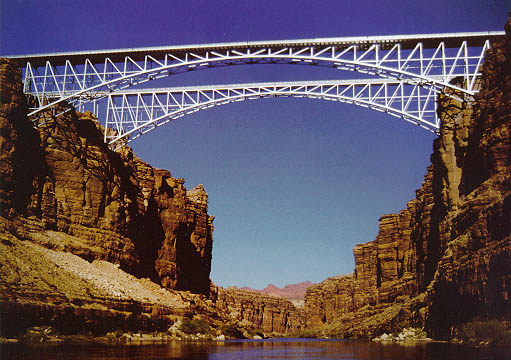Blue Highways: Somewhere on US 93, Nevada
Unfolding the Map
Click on Thumbnail for MapWe have our place in the universe, and what a grand and infinite universe it is! We stop with William Least Heat-Moon (LHM) on a lonely stretch of highway in Nevada, look up at the stars, and are amazed what we see and humbled and comforted all at the same time. Click on the thumbnail of the map at right to fix our place in the cosmos of Blue Highways.
Book Quote
"I've read that a naked eye can see six thousand stars in the hundred billion galaxies, but I couldn't believe it, what with the sky white with starlight. I saw a million stars with one eye and two million with both. Galileo proved that the rotation and revolution of the earth give stars their apparent movements. But on that night his evidence wouldn't hold. Any sensible man, lying on his back among new leaves of sage, in the warm sand that had already dried, even he could see Arcturus and Vega and Betelgeuse just above, not far at all, wheeling about the earth. Their paths cut arcs, and there was no doubt about it.
"The immensity of sky and desert, their vast absences, reduced me. It was as if I were evaporating, and it was calming and cleansing to be absorbed by the vacancy...."
Blue Highways: Part 5, Chapter 5
 On US 93 between Pioche and Ely. Photo by Mike McDonald at Panoramio. Click on photo to go to site.
On US 93 between Pioche and Ely. Photo by Mike McDonald at Panoramio. Click on photo to go to site.
Somewhere on US 93, Nevada
I have been fascinated by the night sky since I can remember. When I was a kid, before I grew up and became jaded, I would often just look up into the night sky in complete wonder at the stars. It helped that I grew up in a very small town on the Northern California coast. Ground light did not really mask the light of the stars there, so I often saw the stars and the distant stream of the Milky Way in all their glory.
When I was around 10 years old, my parents bought me a cheap telescope. I spent hours looking at the moon. That year Comet Kohoutek appeared to the naked eye, and I spent hours in the early mornings training my telescope on the comet as it sat low on the eastern sky. I used to imagine that I actually could see the gasses streaming off of it - it was probably mostly my imagination.
Until I almost ready to graduate, my dream was to become an astronomer. I thought that there would be nothing better than to sit in an observatory, look through telescopes, and study the mysteries of the cosmos. I really had a very romantic notion of them, which can still be stimulated when I see a movie full of sexy astronomers who discover the comets that are going to hit the earth, or hear the first signals from an alien civilization. In reality, I probably would not have been able to handle the physics that I would have needed to know - calculus-based physics did me in when I studied it in college, along with just plain calculus.
As a jaded adult political scientist, I still have a fascination with the sky and the stars. I don't often take time to look up anymore, which is sad. But still, things will catch my eye. A bright planet will get my attention, and I usually will try to find out what planet is sitting on the horizon in the early evening, or close to the moon at midnight. For a long time, I had a screensaver on my computer called seti@home. SETI is the acronym for the Search for Extraterrestrial Intelligence, and the organization had radio telescopes trained on various sections of the sky to see if they could pick up signal patterns that would indicate intelligent communication. The screensaver I had was part of their parallel networking - while my computer was not being used, it was analyzing SETI data and sending it back to SETI. With thousands of home computers doing the same thing, SETI could analyze the data without having to purchase or rent prohibitively expensive supercomputer time.
One of my most meaningful astronomical experiences came in the Davis Mountains of Texas at the McDonald Observatory. My wife and I went to a star party, and there, looking through an amateur astronomer's large telescope, I saw the rings of Saturn and the Great Red Spot on Jupiter for the first time. It was thrilling to see with my naked eye the things that I'd only seen in books before.
Of course, the naked eye experiences are always the best and most gratifying, such as suddenly seeing a constellation like Orion, or learning how Polaris (the North Star) can be found. I remember lying on my back on a hillside once with some friends and watching a meteor shower. Over our heads a large meteor streaked, and then suddenly with a crackling sound, broke up above us. Perhaps the meteor was as large as a small truck high above our heads, but it was fascinating. What fireworks display can match that?
I'm not the only one fascinated by such things. Walking along a dry arroyo in the late afternoon in Chaco Canyon, my wife and I looked for pictographs painted by the Anasazi when Chaco was a thriving center. On an overhang we found them. One of them looked like a star, and it is speculated by some that the painting symbolizes a large supernova that appeared a thousand years ago and was visible for weeks with the naked eye. Today it only appears in telescopes as the Crab Nebula.
Here in New Mexico, we are busy building Spaceport America, where companies like Virgin Galactic will rocket space tourists to a suborbital position at the very edge of outer space, and allow them to experience weightlessness for 10 minutes before re-entering the atmosphere and gliding back to Earth. My wife posted a video where a public relations person for the Spaceport explains the layout of the Spaceport terminal, and another where he explains the activities other than tourism that will happen there. I'd love to go on that ride, but sadly, I don't think I'll ever have the $250,000 in pocket change to pay for a trip, nor the million or so dollars it will take to hitch a ride on a Soyuz capsule to the International Space Station. However, I did get a chance to see the Space Shuttle fly over New Orleans, trailed later by the International Space Station. They were two bright lights in the evening sky, but it touched that fascinated boy in me yet again.
I really need to get out and start looking at the sky again. I need to lay on my back, like LHM did somewhere along the side of US 93 between Pioche and Ely, Nevada, and just watch and wonder. It is a comforting reminder, in a strange way, that I live upon a ball that endlessly revolves around a fiery, stable thermonuclear furnace. That star revolves around the center of a galaxy with an immense, black hole core. That galaxy speeds endlessly toward some unknown fate untold years in the future of the universe. That universe continues to expand. Our lives come and go, but the machinery of the cosmos keeps working.
Here is a favorite poem that I first read in college, and which always brings out the wonder in me when I read it:
Imagine Grass
The planet that we plant upon
rolls through its orbit of the sun,
bending our grass upon the breeze,
While far away the galaxies
in a decelerating pace
reach for the outer edge of space.
Imagine in that final sky
("Give me deceleration; I
will give you mass and curvature.")
at journey's end a far-flung star
of an unnumbered magnitude
Mount Palomar has never viewed.
In that expanded universe
the furthest star will be the first,
poised at the end of everywhere,
on the edge of nothing, like a prayer,
to turn from nothing and retrace,
pulsating through the curve of space.
So many billion light years since
the particle horizon densed,
conceive the universe defined
within the orbit of the mind,
and somewhere in the measured mass
of everything, imagine grass.
Knute Skinner
in A Geography of Poets
(1979, Bantam)
Musical Interlude
What song is better to put to LHM's perusal of the universe than The Beatles' Across the Universe? Here it is for your listening pleasure. Will nothing change your world? Perhaps a night stargazing under a cloudless sky with no light pollution will change it quite a bit.
If you want to know more about US 93
AARoads: US 93
Federal Highway Administration: History of US 93
Wikipedia: US Route 93
Wikipedia: US Route 93 in Nevada
Next up: Ely, Nevada




 Friday, April 29, 2011 at 5:06PM
Friday, April 29, 2011 at 5:06PM



